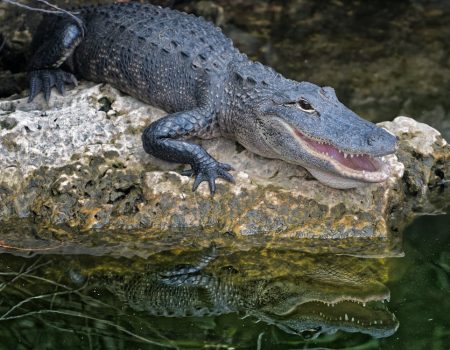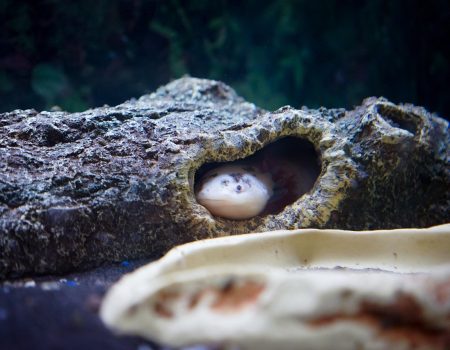Caring for axolotls is rewarding, but there’s a lot to learn to keep them healthy and happy. One thing you might not think about right away is pH levels.
The water chemistry in your axolotl’s tank plays a huge role in their well-being. If the pH is off, it can stress your axolotl and lead to health issues.
But what’s the right level, and how can you keep it steady? Let’s break it down so you can give your little buddy the best possible environment.
Why pH Levels Matter for Axolotls

Your axolotl’s health depends heavily on the quality of their water. The pH level measures how acidic or alkaline the water is. A balanced pH keeps their skin and gills healthy and ensures they can absorb oxygen properly. If the pH is too high or too low, it can cause stress and make them more vulnerable to illness.
Axolotls need 25 to 50% water changes weekly (rinse sponges every time, using old aquarium water).
Axolotls are native to lakes like Xochimilco in Mexico, where the water naturally maintains a neutral to slightly alkaline pH. By replicating these conditions, you’re ensuring your axolotl feels at home.
The Ideal pH Range for Axolotls
Axolotls thrive in water with a pH between 7.4 and 7.6. This range is slightly alkaline but close to neutral. Water outside this range can cause discomfort, skin irritation, and even serious health problems over time.
If the pH falls below 6.5 or rises above 8, your axolotl’s environment becomes unsuitable. Acidic water (low pH) can burn their sensitive skin, while overly alkaline water (high pH) can irritate their gills.
Factors That Affect pH in Axolotl Tanks
Understanding what influences your tank’s pH helps you keep it within the ideal range. Several factors come into play:
- Tap Water Source: Tap water varies by location. Some areas naturally have higher pH levels due to minerals like calcium and magnesium.
- Tank Decorations: Rocks, driftwood, and substrate can raise or lower pH. For example, limestone increases pH, while certain types of driftwood make water more acidic.
- Tank Maintenance: Regular cleaning helps control pH swings caused by waste buildup.
- Water Additives: Products like water conditioners or dechlorinators can impact pH.
A minimum aquarium size of 15 gallons is recommended for the first axolotl, with an additional 10 gallons for each additional axolotl.
Keeping these factors in check ensures your axolotl’s water stays stable.
How to Test Your Tank’s pH Level
Testing your tank’s pH is simple and something every axolotl owner should do regularly. Here’s how:
- Use a pH Testing Kit: Kits are affordable and available at most pet stores or online. They usually include strips or a liquid reagent.
- Follow the Instructions: Dip the strip or add drops of reagent to a water sample and compare the color to the chart provided.
- Test Weekly: Regular testing helps you spot changes early before they cause problems.
For added accuracy, consider a digital pH meter. These devices are more precise and especially useful if you’re dealing with fluctuating pH levels.
Tips for Maintaining the Ideal pH Range
Maintaining a stable pH isn’t hard, but it requires consistency. These tips will help:
Choose the Right Substrate and Decorations
The substrate and decorations in your tank can subtly affect pH. For axolotls, avoid substrates that leach chemicals or alter water chemistry dramatically.
- Sand is a safe option and doesn’t affect pH.
- Avoid crushed coral or limestone unless you’re trying to raise the pH.
Axolotls thrive in water temperatures between 15°C and 21°C, with a preferred range of 16°C to 18°C for breeding.
Driftwood can lower pH over time, so monitor it if you’re using this for decoration.
Perform Regular Water Changes
Regular water changes are one of the easiest ways to stabilize pH. Replace 20-30% of the water weekly to prevent waste buildup, which can make the water acidic. Always test your tap water to ensure its pH is close to your tank’s before adding it.
Use pH Buffers Sparingly
Commercial pH buffers can help raise or lower pH, but they should be used carefully. Overusing them can cause sudden changes, which stress axolotls. Opt for natural methods when possible, like adding aquarium-safe rocks to raise pH or driftwood to lower it.
Monitor Ammonia and Nitrate Levels
High ammonia and nitrate levels often accompany pH problems. Use a comprehensive water testing kit to check for these and address any spikes immediately. Maintaining a well-cycled tank minimizes these risks.
Troubleshooting Common pH Problems
Even with the best care, pH issues can happen. Here’s how to handle common scenarios:
Low pH (Too Acidic)
If your tank’s pH drops below 7.4, here’s what you can do:
- Add Baking Soda: Mix a small amount into water before adding it to the tank. This raises the pH naturally.
- Check the Substrate: Remove any decaying material or decorations causing acidity.
- Increase Aeration: Oxygenating the water can help balance pH.
High pH (Too Alkaline)
If the pH rises above 7.6, try these steps:
- Add Driftwood: This lowers pH gradually and naturally.
- Introduce Peat Moss: Place a small bag in the filter to reduce alkalinity.
- Avoid Overcleaning: Removing too much beneficial bacteria can destabilize the tank.
Fluctuating pH
If your pH swings between tests, focus on consistency:
- Test your water source and adjust it before adding it to the tank.
- Stick to a regular cleaning schedule to prevent sudden chemical changes.
- Avoid overstocking the tank, as too many axolotls or tankmates increase waste.
Practical Examples for Real-World Application
Let’s say you’re noticing sluggish behavior or irritation in your axolotl. A quick pH test reveals the water is too acidic. Adding a small amount of baking soda and replacing some water with fresh tap water helps rebalance the pH. Within hours, your axolotl perks up and seems more comfortable.
Or, maybe you’ve added new decorations, and the pH unexpectedly rises. Removing limestone rocks and adding driftwood solves the problem without needing chemical buffers.
These steps show how understanding pH management keeps your axolotl healthy.
Why Stable pH Is More Important Than Perfection
While the ideal pH range for axolotls is 7.4 to 7.6, what matters most is stability. Sudden changes stress your axolotl more than a slight variation in pH. By testing regularly, maintaining your tank, and addressing issues early, you’ll create a safe, stable home for your axolotl.
Keep Your Axolotl Healthy With the Right pH Balance
Caring for your axolotl’s tank isn’t just about keeping the water clear—it’s about maintaining the perfect environment for their health. A stable pH between 7.4 and 7.6 makes all the difference in their comfort and well-being.
Start testing your tank’s pH today and make small adjustments as needed. With the right care, your axolotl will thrive and stay happy for years to come.
References
Ideal pH for an Axolotl Tank – Caudata.org
How to safely raise pH? – Reddit
Axolotl Water Parameters – Axolotling
Axolotl Care Sheet – Water Critters
Axolotl Requirements – Axolotl.org
Disclaimer
This content on Bagrica is for informational purposes only. Consult a professional for pet care or farming advice. Bagrica is not liable for any actions taken based on this information.







No Comment! Be the first one.